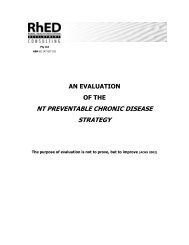DHF Annual Report 2009 - NT Health Digital Library - Northern ...
DHF Annual Report 2009 - NT Health Digital Library - Northern ...
DHF Annual Report 2009 - NT Health Digital Library - Northern ...
You also want an ePaper? Increase the reach of your titles
YUMPU automatically turns print PDFs into web optimized ePapers that Google loves.
1 The Alcohol and Other Drugs Program delivers a range of vocational education and trainingaccredited qualifications, where a qualification comprises 14 units. Alcohol and Other Drug workers ingovernment and non government settings can participate in one or more of these units that comprise aqualification.2 An episode of alcohol and other drugs treatment is a "period of contact, with defined dates ofcommencement and cessation, between a client and a treatment provider that occurs in one settingand in which there is no change in the main treatment type or principal drug of concern, and there hasnot been a non planned absence of contact for greater than three months" (National <strong>Health</strong> DataDictionary). A closed episode of treatment is one where there is a valid date of cessation. Treatmentservices submit data one quarter in arrears and so the count reported here is for the 12 months 1April<strong>2009</strong> to 31 March 2010.3 The number of episodes provided in the non-government sector through agencies funded by theAlcohol and Other Drugs Program.4 The number of episodes provided in the government sector through agencies directly funded andadministered by the Alcohol and Other Drugs Program.Key AchievementsTreatment and careThe Alcohol and Other Drugs Program delivers and funds a range of community basedtreatment services and programs, including withdrawal services, residential rehabilitation,outpatient counselling, pharmacotherapy services and aftercare.In <strong>2009</strong>-10, AODP invested a total of $8.6 million funding into 30 treatment services toprovide 3587 episodes of treatment across the <strong>Northern</strong> Territory, with alcohol continuing tobe the principal drug of concern at 67% of all episodes.A summary of treatment episodes is shown in Table 26 below.Table 26: Number of closed episodes of treatment in Alcohol and Other Drug Treatment Services byprincipal drug of concern, 1 April 2008 - 31 March <strong>2009</strong> and 1 April <strong>2009</strong> – 31 March 2010. OtherDrug Treatment Services by principal drug of concern, 1 April 2008 - 31 March <strong>2009</strong> and 1 April<strong>2009</strong> – 31 March 2010.Principal drug of concern Apr 08 - Mar 09 Apr 09 – Mar 10Alcohol 2 409 2 398Amphetamines 75 96Cannabis 381 294Opioids 312 306Volatile substances 119 238Other 113 255As shown in Table 27, during the period April <strong>2009</strong>–March 2010, assessment only wasthe most common main treatment type provided (38% or 1367 episodes), followed bycounselling (20% or 714 episodes) and residential rehabilitation (15% or 548 episodes).162Department <strong>Health</strong> and Families
















